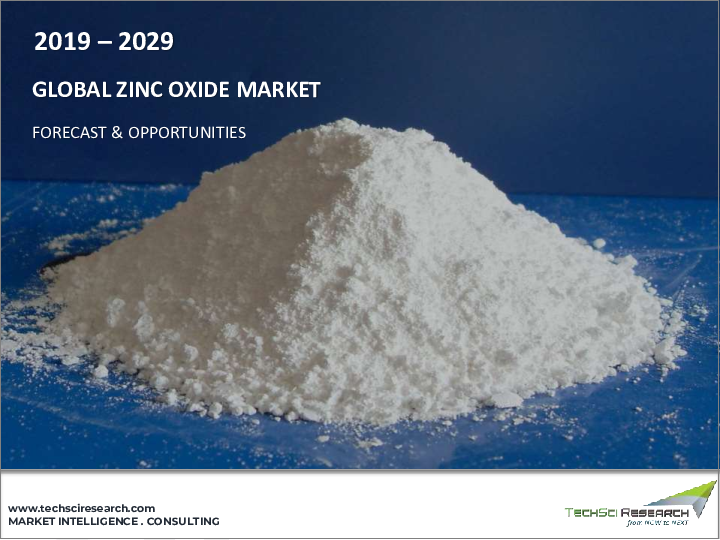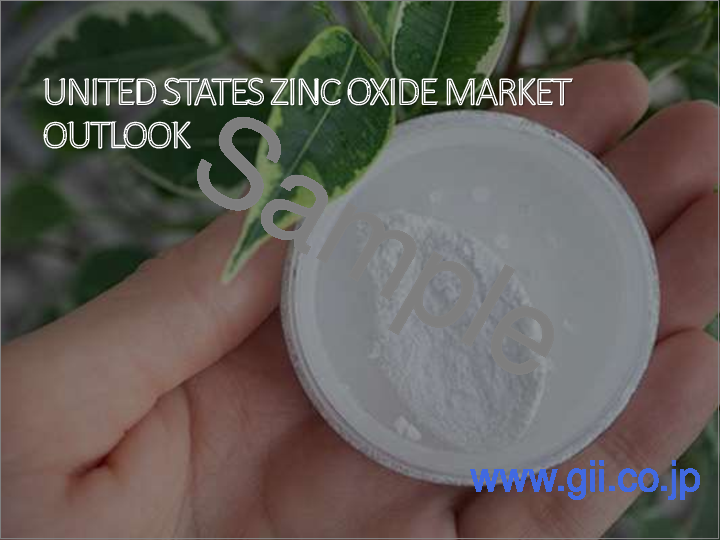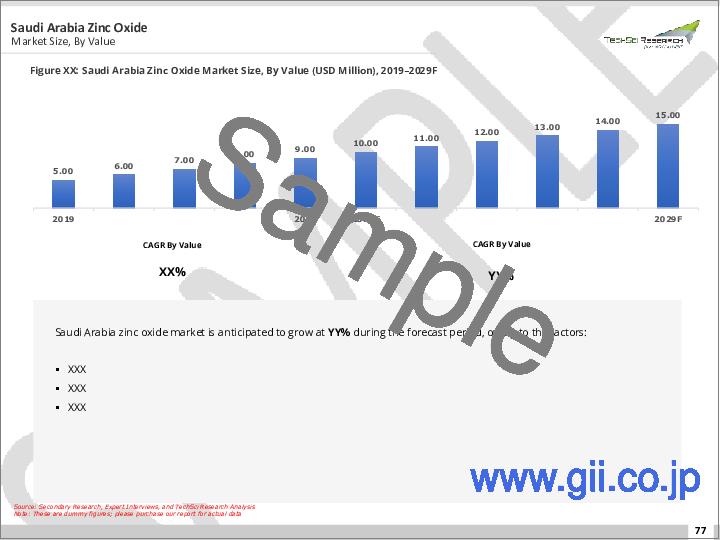|
|
市場調査レポート
商品コード
1460654
酸化亜鉛市場:世界の産業規模、シェア、動向、機会、予測、形態別、エンドユーザー別、地域別、競合別(2019年~2029年)Zinc Oxide Market - Global Industry Size, Share, Trends, Opportunity, and Forecast, Segmented By Form, By End User, By Region and Competition, 2019-2029F |
||||||
カスタマイズ可能
|
|||||||
| 酸化亜鉛市場:世界の産業規模、シェア、動向、機会、予測、形態別、エンドユーザー別、地域別、競合別(2019年~2029年) |
|
出版日: 2024年04月03日
発行: TechSci Research
ページ情報: 英文 185 Pages
納期: 2~3営業日
|
- 全表示
- 概要
- 目次
酸化亜鉛の世界市場は2023年に53億8,000万米ドルとなり、2029年までのCAGRは4.68%で、予測期間中に力強い成長が予測されています。
ゴム産業、特に自動車タイヤ部門は酸化亜鉛の重要な消費者です。この汎用性の高い製品は、ゴムコンパウンドの熱分散性を高め、耐摩耗性を向上させ、弾力性を高め、最終的にタイヤの耐久性と性能に貢献するために広く使用されています。COVID-19パンデミック後の自動車産業の回復に伴い、タイヤの需要が急増すると予想され、酸化亜鉛市場の成長を牽引しています。
酸化亜鉛市場のもう一つの主要促進要因は、活況を呈している化粧品産業での利用拡大です。酸化亜鉛はその日焼け防止特性で有名で、日焼け止めの一般的な成分であり、有害なUVAとUVB光線に対する幅広い防御を提供します。皮膚の健康の重要性に対する意識が高まり続けるにつれ、スキンケアやサンケア製品における酸化亜鉛の需要も高まっています。
しかし、その成長の可能性にもかかわらず、酸化亜鉛市場はある課題に直面しています。酸化亜鉛の生産と使用に関連する環境問題や健康被害が規制上の懸念を引き起こしています。規制の強化は市場の成長に影響を与える可能性があり、より持続可能で環境に優しい生産プロセスの採用が必要となります。とはいえ、こうした課題は、より安全で環境に配慮した酸化亜鉛製造のアプローチを開発する革新的企業にとってはチャンスでもあります。
主な市場促進要因
自動車産業からの酸化亜鉛需要の増大
農業産業からの酸化亜鉛需要の増大
主な市場課題
高品位鉱石の限られた入手可能性
主な市場動向
セラミックスとガラス製造における酸化亜鉛の使用拡大
セグメント別洞察
形状別インサイト
エンドユーザーインサイト
地域別インサイト
目次
第1章 概要
第2章 調査手法
第3章 エグゼクティブサマリー
第4章 COVID-19が酸化亜鉛の世界市場に与える影響
第5章 世界の酸化亜鉛市場の展望
- 市場規模予測
- 金額別
- 市場シェア予測
- 形態別(パウダー、ペレット)
- エンドユーザー別(自動車、建築、塗料、製薬、農業、その他)
- 地域別
- 企業別(2023年)
- 市場マップ
第6章 アジア太平洋地域の酸化亜鉛市場の展望
- 市場規模予測
- 金額別
- 市場シェア予測
- 形態別
- エンドユーザー別
- 国別
- アジア太平洋地域:国別分析
- 中国
- インド
- オーストラリア
- 日本
- 韓国
第7章 欧州の酸化亜鉛市場の展望
- 市場規模予測
- 金額別
- 市場シェア予測
- 形態別
- エンドユーザー別
- 国別
- 欧州:国別分析
- フランス
- ドイツ
- スペイン
- イタリア
- 英国
第8章 北米の酸化亜鉛市場の展望
- 市場規模予測
- 金額別
- 市場シェア予測
- 形態別
- エンドユーザー別
- 国別
- 北米:国別分析
- 米国
- メキシコ
- カナダ
第9章 南米の酸化亜鉛市場の展望
- 市場規模予測
- 金額別
- 市場シェア予測
- 形態別
- エンドユーザー別
- 国別
- 南米:国別分析
- ブラジル
- アルゼンチン
- コロンビア
第10章 中東・アフリカの酸化亜鉛市場の展望
- 市場規模予測
- 金額別
- 市場シェア予測
- 形態別
- エンドユーザー別
- 国別
- 中東アフリカ:国別分析
- 南アフリカ
- サウジアラビア
- アラブ首長国連邦
第11章 市場力学
- 促進要因
- 課題
第12章 市場動向と発展
- 最近の動向
- 製品発表
- 合併・買収
第13章 酸化亜鉛の世界市場SWOT分析
第14章 ポーターのファイブフォース分析
- 業界内の競合
- 新規参入の可能性
- サプライヤーの力
- 顧客の力
- 代替品の脅威
第15章 PESTLE分析
第16章 競合情勢
- Akrochem Corporation
- EverZinc Group SA
- Hakusui Tech Co Ltd
- Hindustan Zinc Limited
- Silox SA
- Weifang Longda Zinc Industry Co. Ltd
- Zinc Industrias Nacionales SA
- ZM SILESIA SA
- Zochem LLC
- Rubamin Pvt Ltd
第17章 戦略的提言
第18章 免責事項
Global Zinc Oxide Market was valued at USD 5.38 billion in 2023 and is anticipated to project robust growth in the forecast period with a CAGR of 4.68% through 2029. The rubber industry, particularly the automotive tire sector, is a significant consumer of zinc oxide. This versatile product is widely used to enhance heat dispersion, improve abrasion resistance, and increase resilience in rubber compounds, ultimately contributing to the durability and performance of tires. With the rebounding automotive industry post-COVID-19 pandemic, the demand for tires is expected to surge, thereby driving the growth of the zinc oxide market.
Another key driver of the zinc oxide market is its increased utilization in the booming cosmetics industry. Zinc oxide, renowned for its sun protection properties, is a common ingredient in sunscreens, offering broad-spectrum defense against harmful UVA and UVB rays. As awareness about the importance of skin health continues to grow, so does the demand for zinc oxide in skincare and sun care products.
However, despite its growth potential, the zinc oxide market faces certain challenges. Environmental concerns and health hazards associated with zinc oxide production and usage have raised regulatory concerns. Stricter regulations may impact market growth and necessitate the adoption of more sustainable and eco-friendly production processes. Nevertheless, these challenges also present opportunities for innovative companies to develop safer and environmentally conscious approaches to zinc oxide manufacturing.
Key Market Drivers
Growing Demand of Zinc Oxide from Automotive Industry
Zinc oxide plays a crucial and indispensable role in the automotive industry, especially in tire manufacturing. This remarkable compound acts as a vital activator during the vulcanization process of rubber, facilitating improved heat dispersion, enhanced resilience, and superior abrasion resistance. As a result, it contributes to the production of higher quality tires that can endure even the harshest conditions, ensuring their longevity and reliability.
Moreover, zinc oxide finds its utility beyond tire manufacturing. It is widely utilized in the production of car batteries, where it serves as an effective corrosion inhibitor, safeguarding the battery's integrity and prolonging its lifespan. Additionally, this versatile compound is employed in car paint formulations, offering valuable UV protection that not only preserves the aesthetics of vehicles but also contributes to their long-lasting durability.
Considering the recent rebound of the automotive industry following the challenging times induced by the COVID-19 pandemic, the demand for tires, and consequently, zinc oxide, is projected to witness a significant surge. Furthermore, the growing popularity of electric vehicles (EVs) further amplifies the demand for zinc oxide. With EVs typically having heavier weight compared to conventional vehicles, the need for more robust and durable tires becomes imperative, thereby driving the demand for zinc oxide in tire manufacturing to even greater heights.
Growing Demand of Zinc Oxide from Agriculture Industry
Zinc oxide, a versatile compound, plays a critical role in agriculture as an essential micronutrient in fertilizers. It not only contributes to plant nutrition but also actively participates in protein synthesis and energy production, promoting robust plant growth and maximizing yield potential. Moreover, the remarkable antimicrobial properties of zinc oxide nanoparticles make them an increasingly popular choice in agriculture, offering a sustainable and eco-friendly alternative to conventional pesticides.
With the global population rapidly increasing, the agriculture industry faces the daunting challenge of meeting the escalating demand for food. To address this, farmers are actively seeking ways to optimize crop yield, leading to a growing need for fertilizers enriched with vital micronutrients like zinc oxide.
Additionally, as the importance of sustainable farming practices gains traction, there is a surging demand for zinc oxide. Farmers are embracing environmentally friendly pest management strategies, such as the utilization of zinc oxide nanoparticles, to mitigate the detrimental impacts of traditional pesticides on the ecosystem.
Key Market Challenges
Limited Availability of High-Grade Ores
High-grade zinc oxide ores, characterized by their high purity and zinc oxide content, play a critical role in the production of top-quality zinc oxide. This versatile compound finds extensive application in diverse industries such as pharmaceuticals, cosmetics, and agriculture. By leveraging high-grade ores, manufacturers can achieve more efficient production processes and deliver superior quality products to meet the demanding market requirements.
However, the limited availability of high-grade zinc oxide ores poses a significant challenge to ensure a steady supply of raw materials. The scarcity of these ores acts as a constraint on the growth potential of the zinc oxide market. Compounding this issue is the global trend of decreasing ore grades in metallic mining, which further exacerbates the situation. While there is no specific data available on global average mined ore grades for zinc, it is widely recognized that ore grades for many metallic minerals are declining on a global scale. This alarming trend implies that a larger volume of ore needs to be processed to obtain the same amount of metal, leading to increased production costs and heightened environmental impacts.
Furthermore, although zinc oxide ores are generally considered to be less problematic from a metallurgical and environmental standpoint compared to zinc sulfide ores, processing lower-grade ores can still present challenges. The extraction and refinement of these ores often entail higher energy consumption, greater water usage, and increased waste generation. These factors need to be carefully considered and managed to ensure sustainable and eco-friendly practices throughout the zinc oxide production process.
Key Market Trends
Growing Use of Zinc Oxide in Ceramics and Glass Manufacturing
Zinc oxide, a highly versatile compound, finds numerous applications in the ceramics and glass industries. In the ceramics industry, it serves as a multifunctional additive that enhances the production of glazes, enamels, and pigments. Notably, zinc oxide contributes to the attractive finish of ceramic products, thanks to its late and vigorous melting properties, making it particularly beneficial for low fire glazes and fast-fire applications. Additionally, its unique ability to crystallize plays a crucial role in the preparation of glass-ceramic glazes, resulting in stunning and durable finishes.
In the realm of glass manufacturing, zinc oxide proves its worth as a melting point reducer, improving the efficiency of the manufacturing process. By lowering the melting point, it allows for lower energy consumption and faster production cycles. Furthermore, the addition of zinc oxide to glass-ceramics can enhance their physio-mechanical properties, resulting in increased density and improved durability.
With its versatility and wide range of applications, zinc oxide continues to be a vital component in the ceramics and glass industries, enabling the production of high-quality and visually appealing products.
Segmental Insights
Form Insights
Based on the category of form, the powder segment emerged as the dominant player in the global market for zinc oxide in 2023. Zinc oxide powder is widely utilized in numerous applications due to its versatility and effectiveness. It finds extensive use in various industries, including batteries, lubricants, friction materials, gold and silver extraction, spray galvanizing, and many others.
In the realm of paints, zinc oxide powder plays a crucial role in providing exceptional UV and corrosion protection. Its finely powdered form, consisting of irregular particles ranging from 4 to 10 microns, allows for optimal dispersion and coverage. Furthermore, this versatile powder is not limited to paint applications alone. It is also instrumental in the manufacturing of zinc-rich paint formulations, as well as in the production of essential chemicals like sodium hydrosulfite and zinc phosphide.
With its broad range of uses and unmatched reliability, powdered ZnO continues to be a staple ingredient in various industries, delivering exceptional performance and superior results.
End User Insights
The automotive segment is projected to experience rapid growth during the forecast period. The growth of the tire industry can be attributed to the high demand for rubber, as it is primarily used in the manufacturing of tires for automobiles. One crucial component in the production process is ZnO, which plays a vital role in the vulcanization of rubber. Additionally, ZnO serves as a cross-linking or curing agent for halogen-containing elastomers such as polysulfides and neoprene. These elastomers require the unique properties of ZnO to enhance their performance and durability, making it an essential ingredient in the rubber industry.
Regional Insights
Asia Pacific emerged as the dominant player in the Global Zinc Oxide Market in 2023, holding the largest market share in terms of value. The increasing demand for ZnO is primarily attributed to the advancements in the automobile, construction, personal care, and cosmetics industries in countries such as India, China, Japan, and South Korea. Additionally, the expanding pharmaceutical industry is expected to further fuel the demand for ZnO due to its numerous beneficial properties. These properties include anti-inflammatory, antiseptic, drying, and ultraviolet protection capabilities, which make ZnO a versatile and sought-after ingredient in various applications.
Key Market Players
Akrochem Corporation
EverZinc Group SA
Hakusui Tech Co Ltd
Hindustan Zinc Limited
Silox SA
Weifang Longda Zinc Industry Co. Ltd
Zinc Industrias Nacionales SA
ZM SILESIA SA
Zochem LLC
Rubamin Pvt Ltd
Report Scope:
In this report, the Global Zinc Oxide Market has been segmented into the following categories, in addition to the industry trends which have also been detailed below:
Global Zinc Oxide Market,By Form:
- Powder
- Pellets
Global Zinc Oxide Market,By End User:
- Automotive
- Construction
- Paints Coatings
- Pharmaceutical
- Agriculture
- Others
Global Zinc Oxide Market, By Region:
- North America
- United States
- Canada
- Mexico
- Europe
- France
- United Kingdom
- Italy
- Germany
- Spain
- Asia Pacific
- China
- India
- Japan
- Australia
- South Korea
- South America
- Brazil
- Argentina
- Colombia
- Middle East Africa
- South Africa
- Saudi Arabia
- UAE
Competitive Landscape
Company Profiles: Detailed analysis of the major companies present in the Global Zinc Oxide Market.
Available Customizations:
Global Zinc Oxide Market report with the given market data, Tech Sci Research offers customizations according to a company's specific needs. The following customization options are available for the report:
Company Information
Detailed analysis and profiling of additional market players (up to five).
Table of Contents
1.Product Overview
- 1.1.Market Definition
- 1.2.Scope of the Market
- 1.2.1.Markets Covered
- 1.2.2.Years Considered for Study
- 1.2.3.Key Market Segmentations
2.Research Methodology
- 2.1.Objective of the Study
- 2.2.Baseline Methodology
- 2.3.Key Industry Partners
- 2.4.Major Association and Secondary Sources
- 2.5.Forecasting Methodology
- 2.6.Data Triangulation Validation
- 2.7.Assumptions and Limitations
3.Executive Summary
- 3.1.Overview of the Market
- 3.2.Overview of Key Market Segmentations
- 3.3.Overview of Key Market Players
- 3.4.Overview of Key Regions/Countries
- 3.5.Overview of Market Drivers, Challenges, Trends
4.Impact of COVID-19 on Global Zinc Oxide Market
5.Global Zinc Oxide Market Outlook
- 5.1.Market Size Forecast
- 5.1.1.By Value
- 5.2.Market Share Forecast
- 5.2.1.By Form (Powder, Pellets)
- 5.2.2.By End User (Automotive, Construction, Paints Coatings, Pharmaceutical, Agriculture, Others)
- 5.2.3.By Region
- 5.2.4.By Company (2023)
- 5.3.Market Map
6.Asia Pacific Zinc Oxide Market Outlook
- 6.1.Market Size Forecast
- 6.1.1.By Value
- 6.2.Market Share Forecast
- 6.2.1.By Form
- 6.2.2.By End User
- 6.2.3.By Country
- 6.3.Asia Pacific: Country Analysis
- 6.3.1.China Zinc Oxide Market Outlook
- 6.3.1.1.Market Size Forecast
- 6.3.1.1.1.By Value
- 6.3.1.2.Market Share Forecast
- 6.3.1.2.1.By Form
- 6.3.1.2.2.By End User
- 6.3.1.1.Market Size Forecast
- 6.3.2.India Zinc Oxide Market Outlook
- 6.3.2.1.Market Size Forecast
- 6.3.2.1.1.By Value
- 6.3.2.2.Market Share Forecast
- 6.3.2.2.1.By Form
- 6.3.2.2.2.By End User
- 6.3.2.1.Market Size Forecast
- 6.3.3.Australia Zinc Oxide Market Outlook
- 6.3.3.1.Market Size Forecast
- 6.3.3.1.1.By Value
- 6.3.3.2.Market Share Forecast
- 6.3.3.2.1.By Form
- 6.3.3.2.2.By End User
- 6.3.3.1.Market Size Forecast
- 6.3.4.Japan Zinc Oxide Market Outlook
- 6.3.4.1.Market Size Forecast
- 6.3.4.1.1.By Value
- 6.3.4.2.Market Share Forecast
- 6.3.4.2.1.By Form
- 6.3.4.2.2.By End User
- 6.3.4.1.Market Size Forecast
- 6.3.5.South Korea Zinc Oxide Market Outlook
- 6.3.5.1.Market Size Forecast
- 6.3.5.1.1.By Value
- 6.3.5.2.Market Share Forecast
- 6.3.5.2.1.By Form
- 6.3.5.2.2.By End User
- 6.3.5.1.Market Size Forecast
- 6.3.1.China Zinc Oxide Market Outlook
7.Europe Zinc Oxide Market Outlook
- 7.1.Market Size Forecast
- 7.1.1.By Value
- 7.2.Market Share Forecast
- 7.2.1.By Form
- 7.2.2.By End User
- 7.2.3.By Country
- 7.3.Europe: Country Analysis
- 7.3.1.France Zinc Oxide Market Outlook
- 7.3.1.1.Market Size Forecast
- 7.3.1.1.1.By Value
- 7.3.1.2.Market Share Forecast
- 7.3.1.2.1.By Form
- 7.3.1.2.2.By End User
- 7.3.1.1.Market Size Forecast
- 7.3.2.Germany Zinc Oxide Market Outlook
- 7.3.2.1.Market Size Forecast
- 7.3.2.1.1.By Value
- 7.3.2.2.Market Share Forecast
- 7.3.2.2.1.By Form
- 7.3.2.2.2.By End User
- 7.3.2.1.Market Size Forecast
- 7.3.3.Spain Zinc Oxide Market Outlook
- 7.3.3.1.Market Size Forecast
- 7.3.3.1.1.By Value
- 7.3.3.2.Market Share Forecast
- 7.3.3.2.1.By Form
- 7.3.3.2.2.By End User
- 7.3.3.1.Market Size Forecast
- 7.3.4.Italy Zinc Oxide Market Outlook
- 7.3.4.1.Market Size Forecast
- 7.3.4.1.1.By Value
- 7.3.4.2.Market Share Forecast
- 7.3.4.2.1.By Form
- 7.3.4.2.2.By End User
- 7.3.4.1.Market Size Forecast
- 7.3.5.United Kingdom Zinc Oxide Market Outlook
- 7.3.5.1.Market Size Forecast
- 7.3.5.1.1.By Value
- 7.3.5.2.Market Share Forecast
- 7.3.5.2.1.By Form
- 7.3.5.2.2.By End User
- 7.3.5.1.Market Size Forecast
- 7.3.1.France Zinc Oxide Market Outlook
8.North America Zinc Oxide Market Outlook
- 8.1.Market Size Forecast
- 8.1.1.By Value
- 8.2.Market Share Forecast
- 8.2.1.By Form
- 8.2.2.By End User
- 8.2.3.By Country
- 8.3.North America: Country Analysis
- 8.3.1.United States Zinc Oxide Market Outlook
- 8.3.1.1.Market Size Forecast
- 8.3.1.1.1.By Value
- 8.3.1.2.Market Share Forecast
- 8.3.1.2.1.By Form
- 8.3.1.2.2.By End User
- 8.3.1.1.Market Size Forecast
- 8.3.2.Mexico Zinc Oxide Market Outlook
- 8.3.2.1.Market Size Forecast
- 8.3.2.1.1.By Value
- 8.3.2.2.Market Share Forecast
- 8.3.2.2.1.By Form
- 8.3.2.2.2.By End User
- 8.3.2.1.Market Size Forecast
- 8.3.3.Canada Zinc Oxide Market Outlook
- 8.3.3.1.Market Size Forecast
- 8.3.3.1.1.By Value
- 8.3.3.2.Market Share Forecast
- 8.3.3.2.1.By Form
- 8.3.3.2.2.By End User
- 8.3.3.1.Market Size Forecast
- 8.3.1.United States Zinc Oxide Market Outlook
9.South America Zinc Oxide Market Outlook
- 9.1.Market Size Forecast
- 9.1.1.By Value
- 9.2.Market Share Forecast
- 9.2.1.By Form
- 9.2.2.By End User
- 9.2.3.By Country
- 9.3.South America: Country Analysis
- 9.3.1.Brazil Zinc Oxide Market Outlook
- 9.3.1.1.Market Size Forecast
- 9.3.1.1.1.By Value
- 9.3.1.2.Market Share Forecast
- 9.3.1.2.1.By Form
- 9.3.1.2.2.By End User
- 9.3.1.1.Market Size Forecast
- 9.3.2.Argentina Zinc Oxide Market Outlook
- 9.3.2.1.Market Size Forecast
- 9.3.2.1.1.By Value
- 9.3.2.2.Market Share Forecast
- 9.3.2.2.1.By Form
- 9.3.2.2.2.By End User
- 9.3.2.1.Market Size Forecast
- 9.3.3.Colombia Zinc Oxide Market Outlook
- 9.3.3.1.Market Size Forecast
- 9.3.3.1.1.By Value
- 9.3.3.2.Market Share Forecast
- 9.3.3.2.1.By Form
- 9.3.3.2.2.By End User
- 9.3.3.1.Market Size Forecast
- 9.3.1.Brazil Zinc Oxide Market Outlook
10.Middle East and Africa Zinc Oxide Market Outlook
- 10.1.Market Size Forecast
- 10.1.1.By Value
- 10.2.Market Share Forecast
- 10.2.1.By Form
- 10.2.2.By End User
- 10.2.3.By Country
- 10.3.MEA: Country Analysis
- 10.3.1.South Africa Zinc Oxide Market Outlook
- 10.3.1.1.Market Size Forecast
- 10.3.1.1.1.By Value
- 10.3.1.2.Market Share Forecast
- 10.3.1.2.1.By Form
- 10.3.1.2.2.By End User
- 10.3.1.1.Market Size Forecast
- 10.3.2.Saudi Arabia Zinc Oxide Market Outlook
- 10.3.2.1.Market Size Forecast
- 10.3.2.1.1.By Value
- 10.3.2.2.Market Share Forecast
- 10.3.2.2.1.By Form
- 10.3.2.2.2.By End User
- 10.3.2.1.Market Size Forecast
- 10.3.3.UAE Zinc Oxide Market Outlook
- 10.3.3.1.Market Size Forecast
- 10.3.3.1.1.By Value
- 10.3.3.2.Market Share Forecast
- 10.3.3.2.1.By Form
- 10.3.3.2.2.By End User
- 10.3.3.1.Market Size Forecast
- 10.3.1.South Africa Zinc Oxide Market Outlook
11.Market Dynamics
- 11.1.Drivers
- 11.2.Challenges
12.Market Trends Developments
- 12.1.Recent Developments
- 12.2.Product Launches
- 12.3.Mergers Acquisitions
13.Global Zinc Oxide Market: SWOT Analysis
14.Porter's Five Forces Analysis
- 14.1.Competition in the Industry
- 14.2.Potential of New Entrants
- 14.3.Power of Suppliers
- 14.4.Power of Customers
- 14.5.Threat of Substitute Product
15.PESTLE Analysis
16.Competitive Landscape
- 16.1.Akrochem Corporation
- 16.1.1.Business Overview
- 16.1.2.Company Snapshot
- 16.1.3.Products Services
- 16.1.4.Financials (As Reported)
- 16.1.5.Recent Developments
- 16.2.EverZinc Group SA
- 16.3.Hakusui Tech Co Ltd
- 16.4.Hindustan Zinc Limited
- 16.5.Silox SA
- 16.6.Weifang Longda Zinc Industry Co. Ltd
- 16.7.Zinc Industrias Nacionales SA
- 16.8.ZM SILESIA SA
- 16.9.Zochem LLC
- 16.10.Rubamin Pvt Ltd





